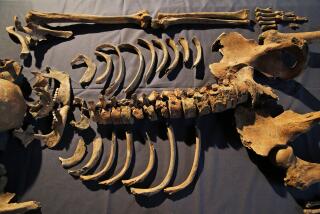Study ties Columbus to spread of syphilis
- Share via
The spread of syphilis across the globe was probably sparked by Christopher Columbus and his crew, who ferried the bacterium, or a version of it, from the New World to the Old World, according to a new genetic analysis published Monday.
A comparison of 23 strains of Treponema pallidum bacterium found that the modern variety that causes the sexually transmitted disease was most closely related to bacteria collected from a remote tribe in Guyana.
Because the tribe has had little contact with the outside world, researchers think the strain is very close to what was circulating in the Americas at the time of Columbus’ voyage in 1492.
The study, published in the journal Public Library of Science Neglected Tropical Diseases, adds more fuel to the long debate over the origin of syphilis.
“There are loose ends, but . . . it looks as if it’s very interesting evidence pointing to New World treponematosis being the ancestor of venereal syphilis,” said Della Collins Cook, a physical anthropologist at Indiana University in Bloomington who was not involved in the study.
But other experts argued that the study’s findings were still not strong enough to overturn a theory that venereal syphilis in Europe evolved from local strains.
A commentary by molecular anthropologist Connie J. Mulligan of the University of Florida and others, published in the same journal, also criticized the study, saying the genetic analysis was too murky to create a clear lineage of the disease.
“I think the jury is still out,” she said.
The venereal form of syphilis is caused by a subspecies of Treponema pallidum.
Other subspecies cause yaws, a tropical disease, and bejel, an illness found in hot, dry climates. Neither of the diseases is usually sexually transmitted.
In the new study, researchers sequenced yaws, bejel and syphilis strains from around the world.
Kristin Harper, an evolutionary biology graduate student at Emory University in Atlanta and lead author of the study, said the team compared the sequences to rabbit syphilis, from which the human variety originally branched off.
The genetic analysis showed that bacteria collected from yaws patients in Guyana were closest to the rabbit strains, although the samples from Guyana were incomplete because they degraded from the tropical heat on the trip back.
Still, the incomplete results agreed with historical documents, which show the first recorded outbreak of venereal syphilis occurred about 1495 when the armies of King Charles VIII of France invaded Naples.
The later disbanding of the army helped spread the disease across Europe.
But Simon Mays, a human skeletal biologist at English Heritage, an advisory body to the British government on historical preservation, noted that other evidence argued that syphilis existed in the Old World long before Columbus.
For example, scientists found evidence of venereal syphilis in the teeth of a skeleton from 13th century Turkey.
The new study “dismisses this evidence much too easily,” Mays said.
Harper acknowledged that the genetic analysis was limited because they didn’t have more of the Guyana strains.
She added the analysis also could not tell if the bacterium Columbus took back was actually venereal syphilis or an organism that developed the ability to transmit sexually as it circulated in Europe.
“We decided to present this evidence because it is very suggestive,” she said.
“The controversy is not going to stop here.”
--






